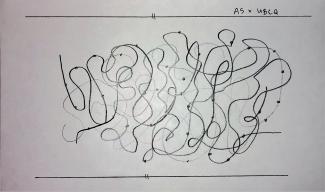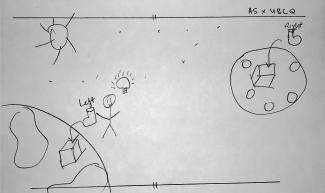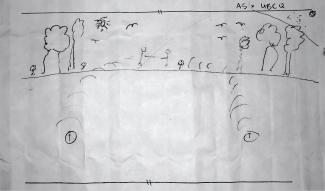Shifted Thinking
Ars Scientia x UBCQ: Shifted Thinking was held on September 22, 2022; a mini-workshop was done in collaboration with the UBC Quantum Club.
Science and art are both fields fortified by their opposites, collaborations, and embracing new perspectives. In bringing together artistic practice and scientific research, Shifted Thinking aimed to uncover dynamic and unexpected outcomes by forcing a shift in perspective.
Shifted Thinking modified an interactive classroom activity called Think-Pair-Share (https://blogs.ubc.ca/teachingamongtrees/2021/11/21/are-you-using-think-pair-share-correctly/), for which a “sketch” step has been inserted.
The participants were first asked to consider the quantum mechanical concept of entanglement and its meaning. They then spent one minute creating a pictorial representation of entanglement while asked to avoid using letters, numbers, symbols, or anything found on a standard keyboard. They are told that their picture can be literal or figurative, realistic or abstract, neat or messy, but: they must draw something. The drawings were then exchanged and discussed among pairs of students, and following that, a more extensive group discussion occurred during which all sketches were made visible.

There are aspects of knowledge that can’t be expressed through words. The action of drawing forced the students to represent a relatively familiar concept (to them) in an otherwise foreign medium, given the context. Sketching helped to highlight the limits of their understanding and to actualize the models and analogies that might otherwise remain hidden in their heads.

Amritabha Guha, who initiated contact with Ars Scientia to develop the activity, reflected, “It was an atypical manner of thinking for me and seemed to hint at some ideas that are otherwise concealed, in a way. By making these ideas perceptible, I can imagine the potential to develop them rather quickly and intuitively. It feels like it could be easier to share them with others more directly.”
Words and pictures complement each other. Sometimes the best approach to solving problems and generating ideas involves a combination of both. Images allow for the addition of layers and dimensions of thought that are almost impossible to achieve with words alone. Words can limit and confine our ideas in a way that pictures don’t so much. Drawings can leave space for what’s still emerging.

Shifted Thinking was an opportunity to engage in conversations surrounding points of intersection and discovery across two seemingly disparate disciplines that had been encouraged to integrate and collaborate.
Guha concluded, “I am delighted with how it went and how the activity carried on in the minds of the participants and generated further engagement.”

Ars Scientia is an interdisciplinary research partnership between Blusson QMI, UBC’s Department of Physics and Astronomy, and the Morris and Helen Belkin Art Gallery. It is a partnership that fosters knowledge exchange across the arts, sciences, and pedagogies.
Sketches created by UBC Quantum Club members during the Shifted Thinking activity.
